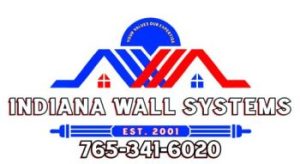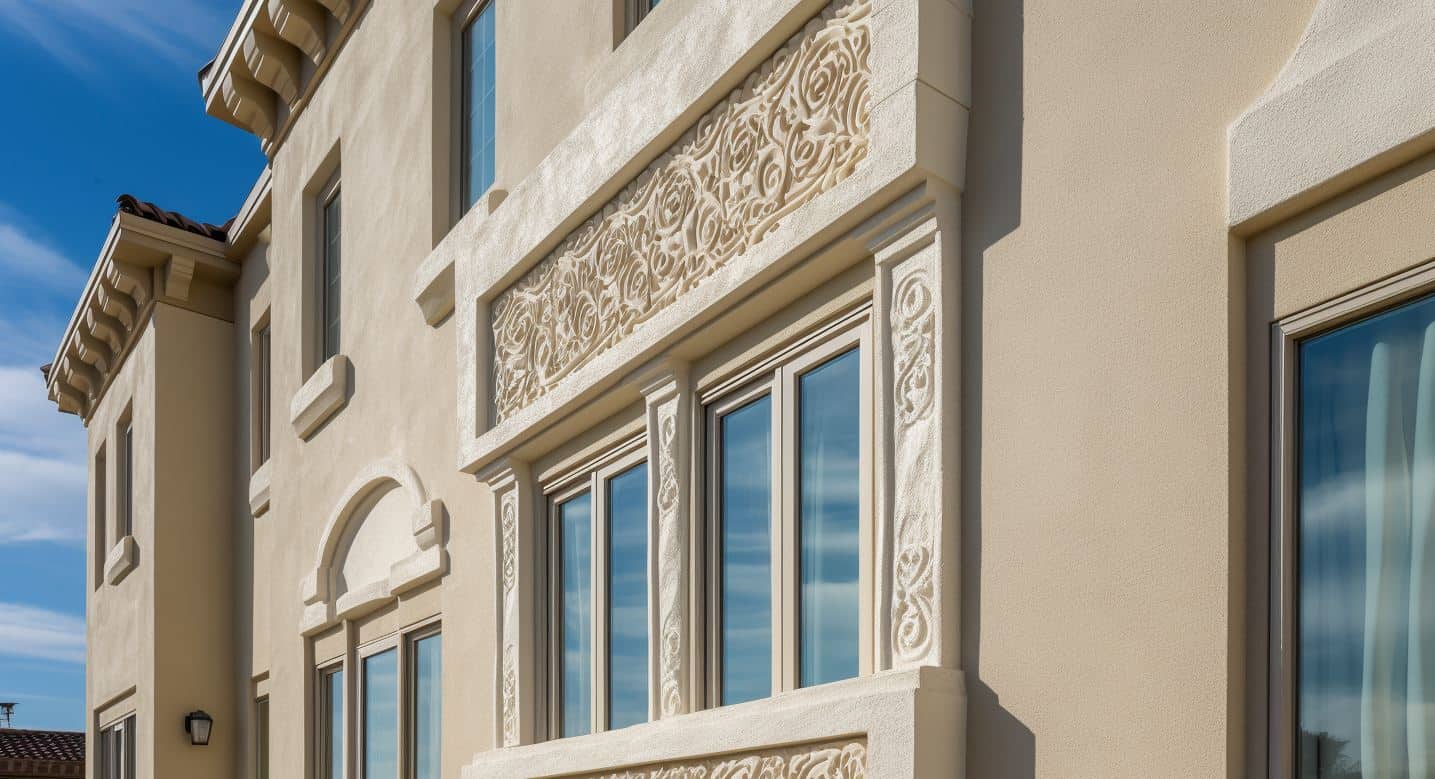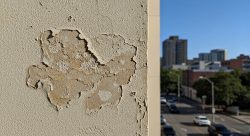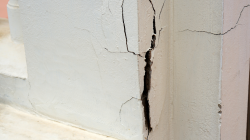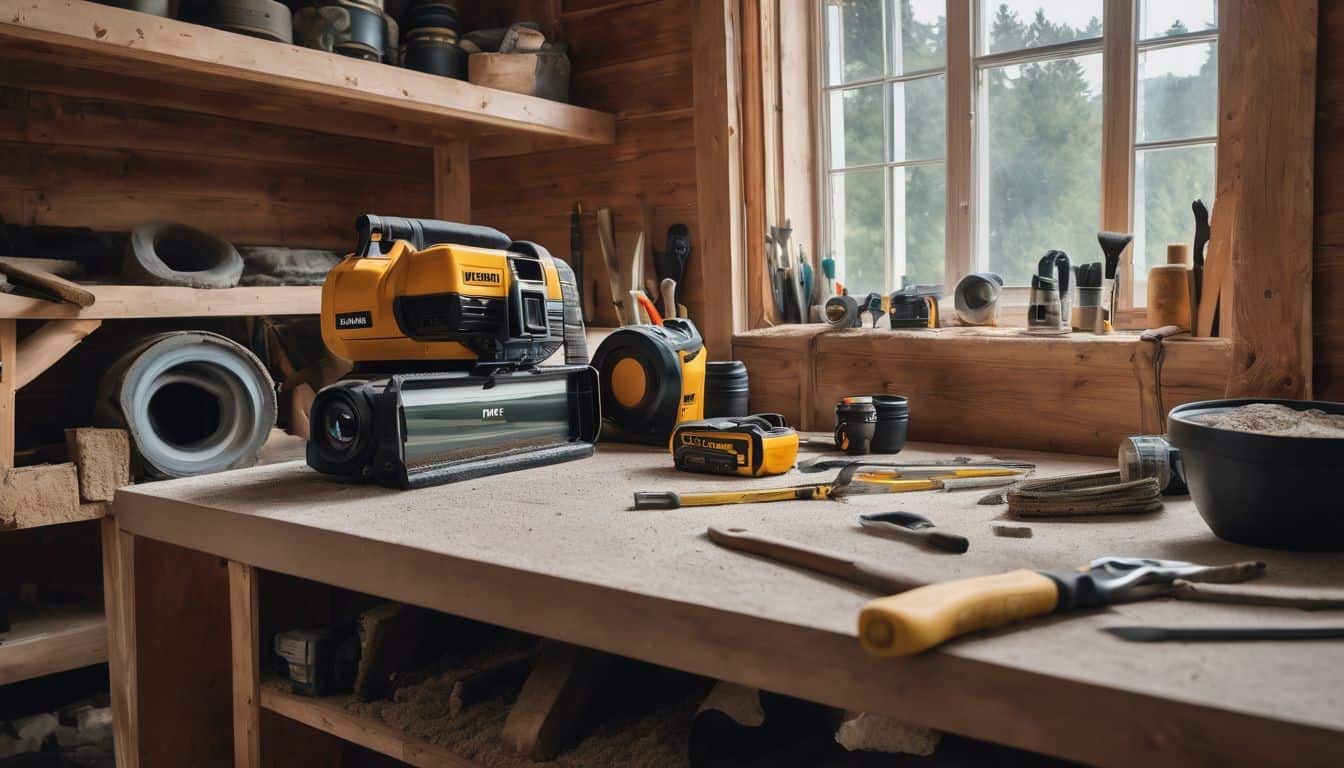Discover What’s Really Causing Those Bubbles on Your Walls—And How to Stop Costly Moisture Damage Before It Starts in Indiana’s Harsh Summer Climate
Have you ever noticed small bubbles forming on your home’s exterior walls during those sticky Indiana summer days? Those aren’t just cosmetic issues – they’re warning signs of a problem that could get much worse if ignored.
I’m Jeff Johnson, owner of Indiana Wall Systems, and over our 22 years in the EIFS business, we’ve seen countless homes suffering from blistering EIFS siding during our hot, humid summers. These bubbles in your exterior insulation and finish system aren’t just ugly – they’re the first sign of potential moisture problems that could lead to expensive repairs down the road.
The good news? You can prevent these issues with the right knowledge and maintenance approach. Our team has fixed thousands of EIFS installations across Central Indiana, and we’ve discovered proven techniques to stop blistering before it starts.
Key Takeaways
- EIFS blistering is primarily caused by trapped moisture and thermal stress during Indiana’s humid summers
- Modern drainage EIFS systems are significantly less prone to blistering than older barrier systems
- Regular maintenance of expansion joints and sealants is crucial for preventing moisture intrusion
- Annual professional inspections can catch small problems before they lead to significant damage
- Proper landscaping and gutter management around your home prevents water from attacking your EIFS
Understanding What Causes EIFS Blistering
Before we dive into solutions, let’s understand what we’re dealing with. EIFS blistering happens when small pockets of air or moisture form between layers of your wall system. In Central Indiana’s climate, these blisters typically appear during our hot, humid summer months.
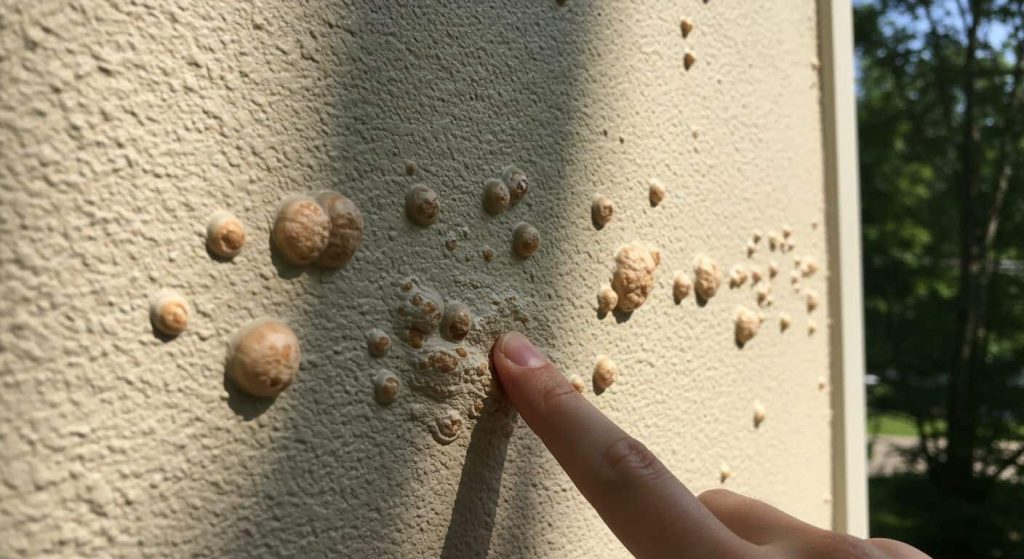
The Science Behind the Bubbles
EIFS blistering isn’t random – it’s physics and chemistry at work on your home’s exterior. During our Indiana summers, several factors combine to create the perfect conditions for blisters:
- High relative humidity levels saturate the air with moisture
- Intense UV exposure heats up your wall surface
- Dramatic temperature swings cause materials to expand and contract
- Thermal expansion stresses the bond between EIFS layers
When moisture gets trapped between the layers of your exterior insulation and finish system, the summer heat causes it to expand as water vapor. With nowhere to go, this vapor creates pressure that pushes outward, forming those tell-tale bubbles in your finish coat.
The Indiana Humidity Factor
Our unique Central Indiana climate makes our homes especially vulnerable. In Indianapolis, Carmel, and surrounding areas, summer humidity regularly exceeds 80% while temperatures fluctuate dramatically. This creates a challenging environment for any exterior cladding system.
When these conditions combine with even small installation flaws or maintenance issues, blistering becomes almost inevitable in older EIFS systems. That’s why proper installation and regular maintenance are so critical for homes in Fishers, Zionsville, Greenwood, and throughout Central Indiana.
Dew Point Condensation: The Hidden Culprit
Many homeowners don’t realize that dew-point condensation plays a major role in EIFS blistering. When warm, humid air contacts a cooler surface (like your air-conditioned walls), moisture condenses. If your EIFS lacks adequate vapor permeability, this condensation gets trapped.
In Indiana’s climate, the dew point can fluctuate dramatically within a single day, creating perfect conditions for condensation within your wall system. Modern EIFS designs account for this with breathable coatings that allow vapor transmission while blocking liquid water.
Types of EIFS Blistering: Identifying Your Problem
Not all blisters are created equal. Knowing which type you’re dealing with helps determine the right solution.
Surface Blisters vs. Deep Delamination
Surface blisters are typically small (pencil eraser to quarter-sized) and only affect the acrylic finish coat. They’re unsightly but generally represent a less serious issue.
Deep delamination creates larger bubbles (often several inches across) and indicates separation between the base coat and insulation board – a much more serious problem that needs immediate professional attention.
The Silent Danger: Internal Moisture
The most concerning type of blistering is often invisible from the outside. Moisture trapped deep within the EIFS can cause the wood sheathing or framing behind to deteriorate without visible external signs. This is why professional moisture testing is so important.
At Indiana Wall Systems, our moisture inspections routinely discover hidden damage that homeowners never suspected was there. Once we start removing damaged sections, clients are often shocked at what we find beneath seemingly minor blisters.
Adhesion Failure Clues
How can you tell if your blisters indicate adhesion failure? Look for these telling signs:
- Blisters that appear in a regular pattern (often following insulation board joints)
- Hollow sounds when you gently tap the surface around the blister
- Blisters that grow larger after rain or high humidity days
- Multiple small blisters clustered together
These symptoms often indicate that the original substrate preparation was inadequate, or that moisture has compromised the adhesive bond between system components.
Barrier EIFS vs. Drainage EIFS: What’s the Difference?
Understanding which type of EIFS you have is crucial for addressing blistering issues properly.
Barrier vs. Drainage EIFS: Understanding the Difference
Barrier EIFS System
Characteristics
- No drainage path for water
- Relies entirely on surface seals
- High risk of trapped moisture
- Simpler installation process
- Prone to blistering in humid climates
- Often requires more maintenance
Drainage EIFS System
Characteristics
- Built-in drainage channels
- Water-resistant barrier protection
- Allows incidental moisture to escape
- Significantly reduced blistering risk
- Better long-term durability
- Slightly more complex installation
Can an Older Barrier System Be Upgraded?
Yes! Indiana Wall Systems specializes in converting barrier EIFS to drainage systems, preserving your investment while improving performance. Ask about our targeted retrofit solutions.
Older Barrier Systems: The Moisture Trap
If your home was built before the early 2000s, you likely have a barrier EIFS system. These older systems were designed to keep all water out – a nearly impossible task in Indiana’s climate. With no way for incidental moisture to escape, these systems are particularly prone to blistering.
Barrier EIFS works like a sealed envelope. When that envelope inevitably gets small tears or gaps, water enters but cannot exit. This trapped moisture is the primary cause of moisture problems in older EIFS installations throughout Indianapolis and surrounding communities.
Modern Drainage Systems: The Game Changer
Newer drainage EIFS (sometimes called “water-managed EIFS”) includes a critical drainage plane behind the insulation. This design allows any water that penetrates the system to safely drain out through weep holes at the bottom.
Modern drainage systems are significantly less prone to blistering because they don’t trap moisture inside the wall assembly. If you’re considering a new EIFS installation or retrofit, drainage systems are absolutely the way to go for Indiana homes.
The Importance of Drainage Cavity Depth
Not all drainage systems are created equal. The effectiveness of a drainage cavity depends on its depth and design. Industry standards now recommend a minimum drainage cavity depth of at least 1/8 inch, with many premium systems offering 3/16 or even 1/4 inch cavities.
This seemingly small detail makes a huge difference in how effectively your wall system can stop water from getting trapped and prevent moisture-related issues. In our Central Indiana installations, we typically recommend the deeper drainage cavities due to our climate’s specific challenges.
Table: Comparing EIFS Types and Blistering Risk
EIFS Types Comparison: Blistering Risk in Indiana Climate
| EIFS Type | Weather Resistance | Blistering Risk | Common in | Best for Indiana? |
|---|---|---|---|---|
| Barrier EIFS | Poor to Moderate | High | Homes built before 2000 | No |
| Water-Managed EIFS | Excellent | Low | Modern construction | Yes |
| PB Systems (Thin Coat) | Varies by design | Moderate | Mixed applications | Only with drainage |
| PM Systems (Thick Coat) | Good | Low to Moderate | Commercial buildings | Yes, with proper details |
Building Envelope Integrity: The Bigger Picture
EIFS blistering is often a symptom of larger building envelope issues. Your home’s exterior isn’t just about looks – it’s a complex system designed to manage air, water, heat, and vapor movement.
Air Barriers and Pressure Differentials
Many blistering problems stem from inadequate exterior air barrier implementation. When indoor and outdoor air pressures differ (which they always do), this creates forces that can drive moisture into wall assemblies.
Modern EIFS installations incorporate comprehensive air barrier strategies to combat this. These systems work by equalizing pressure, preventing the negative air pressure situations that can pull moisture into walls.
Continuous Insulation Benefits
One of EIFS’s greatest advantages is providing continuous insulation layer coverage, which eliminates the thermal bridging common with other cladding types. This consistent thermal performance helps prevent the temperature differentials that contribute to condensation and blistering.
When properly installed and maintained, this continuous insulation creates a stable thermal environment that significantly reduces the thermal stress cracks and temperature-related expansion/contraction cycles that lead to blistering.
7 Key Warning Signs of Impending EIFS Blistering
Don’t wait until bubbles appear! Watch for these early warning signs that blistering may be developing:
- Small cracks in the finish coat, especially near windows and doors
- Discoloration or staining on the EIFS surface
- Soft spots when you press gently on the wall
- Gaps around penetrations like light fixtures or hose bibs
- Failed caulking at expansion joints
- Water stains on interior walls that align with exterior EIFS
- Mold or mildew growing on exterior surfaces
Catching these small EIFS problems early can save you thousands in repairs later. If you notice any of these signs, call a professional EIFS contractor for an inspection immediately.
7 Key Warning Signs of EIFS Problems
Small Cracks in Finish Coat
Look for hairline cracks, especially around windows and doors where building movement is concentrated.
Discoloration or Staining
Yellow or brown spots on your EIFS can indicate moisture trapped behind the system.
Soft Spots When Pressed
EIFS should feel solid. If it feels soft or spongy, moisture has likely compromised the system.
Gaps Around Penetrations
Check around light fixtures, hose bibs, and vents for gaps that could allow water entry.
Failed Caulking at Joints
Deteriorated, cracked, or missing caulk at expansion joints is a major entry point for moisture.
Interior Water Stains
Water stains on interior walls that align with exterior EIFS indicate moisture penetration.
Mold or Mildew Growth
Visible mold on the exterior surface suggests moisture is trapped inside the wall system.
If you notice any of these warning signs, contact a professional EIFS contractor immediately. Early detection can prevent costly repairs.
Contact Indiana Wall SystemsProven Prevention Techniques to Stop EIFS Blistering
After 22 years of repairing EIFS throughout Central Indiana, our team at Indiana Wall Systems has developed a comprehensive approach to preventing blistering.
1. Maintain Your Expansion Joints
The most overlooked maintenance item in EIFS is the humble expansion joint. These critical components allow your wall system to expand and contract with temperature changes.
Over time, the flexible caulking in these joints deteriorates. When that happens, water finds its way in. Inspect all expansion joints annually and replace failing caulk before it allows water intrusion.
Expansion Joint Maintenance Tips:
- Use only elastomeric sealant joints specifically formulated for EIFS
- Remove old, failed sealant completely before applying new material
- Ensure proper joint width-to-depth ratio (typically 2:1)
- Install backer rod in deeper joints before applying sealant
- Apply sealant in temperatures between 40-90°F for optimal curing
2. Create Proper Drainage Around Your Home
Water pooling near your foundation is a major enemy of your EIFS. Ensure your yard has positive slope grading away from the house, with a minimum 6-inch drop in the first 10 feet.
Check that downspouts direct water at least 5 feet away from your walls. And be careful with landscaping irrigation – sprinklers should never spray directly onto your EIFS walls.
Critical Drainage Components:
- Maintain gutter overflow control systems to prevent cascading water during heavy rains
- Install splash blocks or underground drainage for downspouts
- Consider French drains for problem areas with poor natural drainage
- Keep mulch beds at least 2 inches below the bottom edge of your EIFS
- Monitor areas where snow tends to pile up against the house during winter
3. Maintain Proper Clearances
One of the most common installation errors we see is inadequate ground clearance. Your EIFS should never extend below grade or touch soil directly.
Maintain a minimum 6-inch clearance between the bottom of your EIFS and the ground. Also ensure proper clearances around decks, porches, and roof intersections.
Key Clearances for EIFS Performance:
- Weep screed clearance of at least 6 inches above soil, 2 inches above hardscapes
- Minimum 2-inch gap between EIFS and horizontal surfaces like decks
- Proper clearance at roof-wall intersections with appropriate flashing
- Adequate space around penetrations for proper sealing
4. Address Roof and Flashing Issues Promptly
Failed roof-wall intersections and improper window head flashing are major entry points for water. Regular inspection of these areas is crucial.
Make sure all kick-out flashing is properly installed and sealed where roof edges meet walls. This simple detail prevents thousands of dollars in water damage.
Critical Flashing Areas:
- Roof-wall intersection points where rooflines terminate into vertical walls
- Around windows and doors, especially at the tops (head flashing)
- Where decks or porches attach to the house
- Around utility penetrations like electrical, gas, and plumbing lines
- At transitions between EIFS and other materials like brick or siding
5. Control Interior Humidity
Surprisingly, some EIFS blistering starts from the inside out. Excessive indoor humidity, especially in bathrooms and kitchens without proper ventilation, can drive moisture into your walls.
Maintain indoor relative humidity between 30-50% using dehumidifiers if necessary. Ensure bathroom and kitchen exhaust fans vent completely to the exterior, not into attics or wall cavities.
Indoor Humidity Control Strategies:
- Use bathroom fans during and 30 minutes after showers
- Run kitchen exhaust when cooking
- Consider whole-house dehumidification in very humid climates
- Address any plumbing leaks immediately
- Use air conditioning to remove humidity in summer months
6. Implement a Capillary Break Strategy
Water can move through tiny spaces via capillary action – the same physical process that pulls water up through plant roots. Creating effective capillary break points in your EIFS system helps prevent this movement.
Modern EIFS installations include specific materials and details designed to interrupt capillary movement at critical points. If you’re repairing or retrofitting older systems, incorporating these breaks is essential.
7. Schedule Professional Inspections
The single most effective preventive measure is regular professional inspection. At Indiana Wall Systems, we recommend annual EIFS inspection by a qualified contractor who knows what to look for.
Our inspections include:
- Visual assessment of all surfaces
- Non-invasive moisture meter readings at critical points
- Thermal imaging to identify hidden moisture issues
- Sealant evaluation
- Flashing integrity checks
Professional Solutions for Existing EIFS Blistering
If you already have blistering, don’t panic – but don’t ignore it either. Here’s how professionals like our team at Indiana Wall Systems address existing problems:
Surface-Only Repairs
For minor surface blisters that don’t involve deeper moisture issues, we often:
- Remove the damaged finish coat
- Check the reinforcing mesh integrity
- Apply a new factory-mixed base coat
- Finish with a color-matched acrylic finish that blends seamlessly
This approach works well for blisters caused primarily by UV exposure or surface temperature swings rather than trapped moisture.
Deep Moisture Remediation
For more serious cases where moisture has penetrated deeper:
- Remove all damaged materials down to solid substrate
- Allow the area to thoroughly dry
- Treat any wood damage or mold
- Install a proper drainage plane even in retrofits
- Replace with new EIFS components using proper techniques
- Restore the finish to match surrounding areas
System Conversion Options
In some cases, particularly with older homes that have experienced repeated moisture issues, we recommend converting barrier EIFS to drainage EIFS. This involves:
- Keeping the existing insulation where possible
- Adding a proper water management system
- Installing new drainage channels and weep systems
- Replacing the finish system with modern materials
This approach preserves the energy efficiency and appearance benefits of EIFS while dramatically improving moisture management.
Advanced Detection Methods
To determine the full extent of damage, we employ several advanced detection technologies:
Infrared Moisture Scanning
Using infrared moisture scan technology, we can detect temperature differences that indicate moisture within walls without destructive testing. This allows us to precisely target repairs to affected areas only.
Electrical Impedance Scanning
Similar to medical ultrasound, these specialized devices detect moisture by measuring electrical resistance in wall assemblies. This helps us create precise moisture maps of your EIFS system.
Core Sampling
In some cases, small core samples may be necessary to directly assess moisture levels and damage within the wall assembly. These small holes are easily repaired during the remediation process.
The Indiana Wall Systems Summer Maintenance Checklist
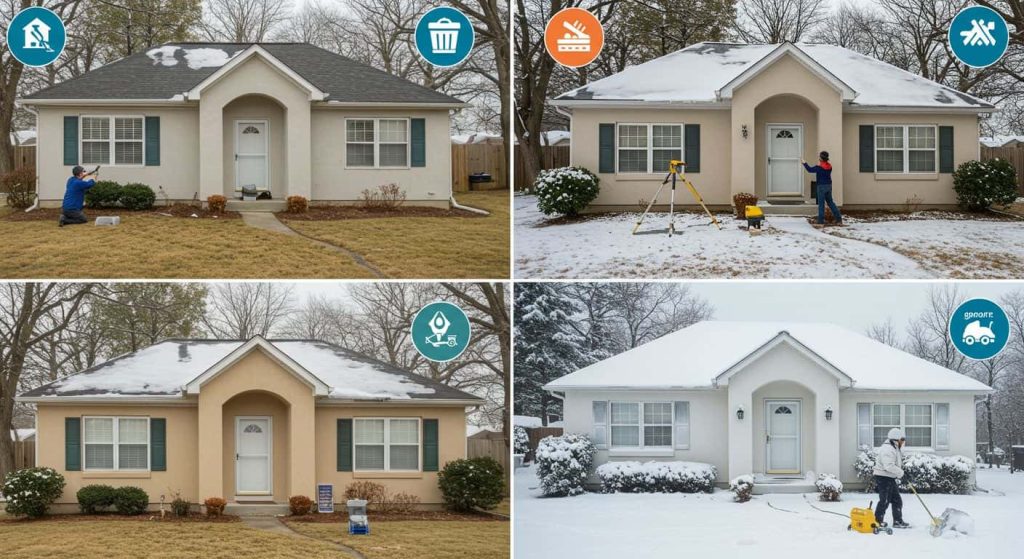
To specifically address summer blistering concerns in Indiana’s unique climate, follow these seasonal maintenance steps:
Early Summer Preparation (May)
- Inspect all sealants for winter damage
- Check irrigation systems to ensure water isn’t hitting EIFS
- Clear vegetation growing against walls
- Ensure air conditioning systems are working properly
- Inspect gutters and downspouts for proper function
Mid-Summer Vigilance (June-July)
- Watch for early signs of blistering during hottest periods
- Monitor indoor humidity levels during humid spells
- Ensure proper attic ventilation to prevent heat buildup
- Keep sprinklers and hoses away from EIFS surfaces
- Check basement dehumidifiers if applicable
Late Summer Repair Window (August-September)
This is the ideal time for sealant replacement and minor repairs because:
- Moderate temperatures are optimal for material curing
- Lower humidity improves adhesion
- Completed repairs have time to fully cure before winter stress
- Rain is typically less frequent, allowing longer work windows
Taking advantage of this late summer maintenance window sets your EIFS up for success through the coming seasons.
The Role of Building Science in EIFS Performance
Modern EIFS solutions are based on sophisticated building science principles that go beyond simple aesthetics. Understanding these principles helps explain why proper installation and maintenance are so critical.
Vapor Drive Dynamics
Moisture moves through building assemblies based on vapor pressure differentials – from areas of high pressure to low pressure. In summer, this often means moisture drives from the hot, humid exterior toward the cooler, air-conditioned interior.
Without proper vapor permeability in your wall system, this natural vapor movement can create pressure buildup that leads to blistering. Modern EIFS designs carefully balance water resistance with vapor transmission to prevent these issues.
Thermal Mass Benefits
One advantage of EIFS is its thermal mass, which moderates temperature swings. This helps reduce the thermal expansion and contraction cycles that stress sealants and finishes.
The continuous insulation layer also prevents the cold spots that can lead to condensation within walls. This thermal consistency is particularly valuable in Indiana’s variable climate.
The Indiana Wall Systems Annual EIFS Maintenance Checklist
| Spring (March-April) | Summer (May-August) | ||
|---|---|---|---|
| High Priority Season |
| Watch for Blisters |
| Fall (September-October) | Winter (November-February) | ||
| Optimal Repair Season |
| Monitor & Plan |
Following this seasonal maintenance schedule will significantly extend the life of your EIFS and prevent costly repairs.
Need help with your EIFS maintenance? Contact Indiana Wall Systems at (765) 341-6020 for professional service.
To keep your EIFS in top condition through Indiana’s challenging seasons, follow this annual maintenance routine:
Spring Inspection (March-April)
- Check for winter damage to sealants
- Inspect all expansion joints
- Look for cracks in the finish coat
- Test sealant flexibility around windows and doors
- Ensure proper weep screed clearance is maintained
Summer Care (May-August)
- Gently clean surfaces with low-pressure washing
- Keep irrigation systems adjusted away from walls
- Monitor for new blisters during hottest months
- Maintain proper air conditioning to control indoor humidity
Fall Preparation (September-October)
- Ensure gutter overflow control is working properly
- Trim vegetation away from EIFS surfaces
- Check that kick-out flashing is secure before winter
- Apply new sealants if needed (optimal temperature for curing)
Winter Monitoring (November-February)
- Watch for ice damming at roof edges
- Monitor interior humidity levels
- Check for condensation on windows (a sign of high indoor humidity)
Following this seasonal approach helps prevent the conditions that lead to blistering and extends the life of your EIFS significantly.
When to Call a Professional EIFS Contractor
While some maintenance can be DIY, certain situations always warrant professional help. Contact an experienced EIFS contractor immediately if:
- You notice soft areas when pressing on your walls
- Blisters appear suddenly or grow rapidly
- You see water stains on interior walls or ceilings
- Cracks larger than 1/16 inch develop in the finish
- Your home is over 15 years old and has never had an EIFS inspection
At Indiana Wall Systems, we offer free EIFS inspections throughout Central Indiana. Our non-invasive moisture detection technology identifies problems before they become disasters.
Comparing EIFS to Other Exterior Cladding Options
While this article focuses on preventing blistering in EIFS, it’s worth understanding how EIFS compares to other common exterior wall covering options in terms of moisture management.
EIFS vs. Traditional Stucco
Traditional stucco is a cement-based system that’s been used for centuries. While it’s durable, it lacks the insulation value of EIFS and can crack more easily. However, traditional stucco is somewhat more forgiving when minor water intrusion occurs.
EIFS offers better insulation value and design flexibility but requires more careful water management. Modern drainage EIFS combines the best of both worlds – the insulation value and aesthetic options of EIFS with improved moisture handling.
EIFS vs. Fiber Cement Siding
Fiber cement products like HardiePlank offer good durability but provide minimal insulation. They manage water differently – relying on overlapping boards and back-flashing rather than a continuous surface.
EIFS creates a more energy-efficient building envelope but requires more attention to details at transitions and penetrations where water might enter.
EIFS vs. Vinyl Siding
Vinyl siding is inherently designed to allow some water penetration, with built-in drainage paths behind the siding. This makes it less prone to trapping moisture, but it offers minimal insulation and less design flexibility.
Modern drainage EIFS combines the superior insulation and aesthetic options of EIFS with moisture management approaches similar to those used in siding systems.
Why Indiana Wall Systems is Central Indiana’s EIFS Expert
With 22 years in the EIFS business and 160 years of combined experience on our team, we’ve seen and solved every type of EIFS blistering problem across Indianapolis, Carmel, Fishers, Greenwood, and beyond.
Our approach combines:
- In-depth knowledge of building science principles
- Certification in all major EIFS manufacturers’ systems
- Specialized equipment including infrared moisture scanning
- Experience with Indiana’s specific climate challenges
- Commitment to using only manufacturer-approved materials and methods
We take a diagnostics-first approach, using non-invasive moisture meters to pinpoint problems before developing a precise repair plan. This saves our clients money by addressing the real causes rather than just symptoms.
Case Study: Preventing Blistering in Carmel, IN
When a Carmel homeowner contacted us about small blisters appearing on his south-facing wall during last summer’s heat wave, we conducted a thorough inspection rather than just treating the visible symptoms.
Project Snapshot
EIFS Blistering Case Study: Carmel, IN
| Property Type | Two-story residence, Carmel, IN |
| System Age | 18 years (original barrier EIFS) |
| Primary Issue | Blistering on south and west elevations |
| Hidden Issues Discovered | Failed sealants at roof-wall intersection |
| Solution Implemented | Targeted drainage retrofit at problem areas |
| Outcome | No new blistering for 3 summers and counting |
Our inspection revealed that the home’s original barrier EIFS had deteriorating sealants where the second-floor walls met the roof. This allowed water to enter during heavy rains, becoming trapped in the system and causing blisters during summer heat.
Rather than just repairing the blisters, we:
- Removed damaged sections
- Installed proper kick-out flashing at roof-wall intersections
- Created a drainage cavity behind the repaired areas
- Applied new base coat with reinforcing mesh
- Finished with a perfectly color-matched finish coat
This targeted approach addressed the root cause while minimizing cost. The homeowner has reported no new blistering for three summers since the repair.
The Indoor-Outdoor Humidity Relationship
Many homeowners don’t realize that indoor comfort and EIFS performance are closely linked. Your home’s HVAC system plays a crucial role in preventing conditions that lead to wall system problems.
Negative Pressure Problems
When your home develops negative air pressure (more air going out than coming in), it can literally pull moisture through walls. Common causes include:
- Exhaust fans running without adequate makeup air
- HVAC systems with return/supply imbalances
- Stack effect in multi-story homes during temperature extremes
This negative pressure can draw humidity into wall cavities, creating ideal conditions for blistering. Proper HVAC balancing helps prevent these issues.
Controlling Indoor Humidity Levels
In Indiana summers, indoor humidity management is essential for both comfort and EIFS performance. We recommend:
- Maintaining indoor relative humidity between 30-50%
- Using dehumidifiers during particularly humid periods
- Ensuring bathroom and kitchen fans vent fully outside
- Monitoring indoor humidity with inexpensive hygrometers
These simple steps help prevent the vapor drive that can push moisture into your walls from the inside out.
Frequently Asked Questions About EIFS Blistering
How much does it cost to repair EIFS blistering in Indiana?
Minor surface repairs typically range from $500-1,500 depending on the area involved. More extensive repairs involving moisture damage can range from $2,500 to $15,000+ for larger sections requiring complete replacement.
Can I paint over blistered EIFS to fix it?
No. Painting over blisters without addressing the underlying cause will only temporarily mask the problem. The blisters will return, and the trapped moisture will continue to cause damage.
How can I tell if my EIFS has a drainage system?
Look for small weep holes at the bottom of the system, usually just above the foundation. You might also see mesh-covered drainage outlets. Homes built after 2000 are more likely to have drainage EIFS, while older installations are typically barrier systems.
Will my homeowner’s insurance cover EIFS blistering repair?
Most standard policies consider EIFS blistering to be a maintenance issue rather than sudden damage, so coverage is unlikely unless the blistering resulted from a covered event like a storm. Check your specific policy for details.
How often should EIFS be inspected in Indiana’s climate?
We recommend annual professional inspections, ideally in spring after winter weather stress has subsided. Homes over 15 years old or with previous moisture issues may benefit from twice-yearly inspections.
Can EIFS blistering lead to mold problems?
Yes. Trapped moisture creates ideal conditions for mold growth. This can affect indoor air quality and potentially cause health issues for residents. Addressing blistering promptly helps prevent these secondary problems.
What’s the best way to clean EIFS without causing damage?
Use gentle, low-pressure washing (under 300 psi) with a mild detergent solution. Avoid pressure washers, which can force water into the system through tiny cracks. For stubborn stains, specialized EIFS cleaners are available that won’t damage the finish.
Conclusion: Protecting Your EIFS Investment
Your EIFS exterior represents a significant investment in your home’s appearance and energy efficiency. By understanding the causes of blistering and implementing proper maintenance, you can protect that investment for decades to come.
Remember that in Indiana’s challenging climate, prevention is always less expensive than remediation. Regular inspection of sealants, proper water management around your home, and prompt attention to small issues before they grow are your best defenses against EIFS blistering.
If you’re noticing signs of blistering or haven’t had your EIFS inspected recently, contact Indiana Wall Systems at (765) 341-6020 for a free evaluation. Our team serves homeowners throughout Central Indiana, including Indianapolis, Carmel, Fishers, and surrounding communities.
Don’t wait until small bubbles become big problems. Call Indiana Wall Systems today!
Looking for more information about maintaining your home’s exterior? Check out our guides on EIFS vs. traditional stucco and how to spot early signs of EIFS wear and tear.
